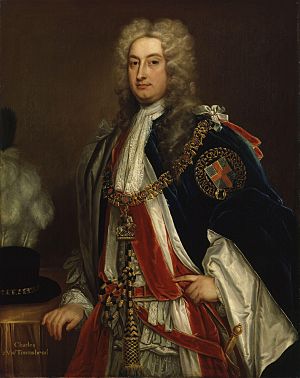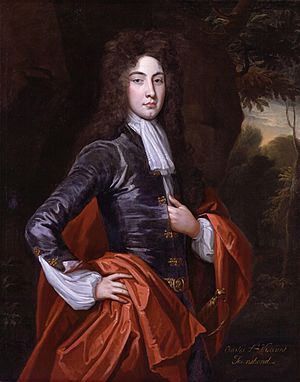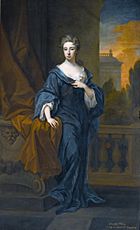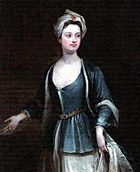Charles Townshend, 2nd Viscount Townshend facts for kids
Quick facts for kids
The Viscount Townshend
|
|
|---|---|

Portrait of Townshend attributed to Charles Jervas, c. 1724, dressed in Garter robes (National Portrait Gallery)
|
|
| Lord President of the Council | |
| In office 11 June 1720 – 25 June 1721 |
|
| Monarch | George I |
| Preceded by | The Duke of Kingston-upon-Hull |
| Succeeded by | The Lord Carleton |
| Personal details | |
| Born | 18 April 1674 Raynham Hall, Norfolk, Kingdom of England |
| Died | 21 June 1738 (aged 64) Raynham Hall, Norfolk, England, Kingdom of Great Britain |
| Parent | Horatio Townshend (father) |
| Education | Eton College |
| Alma mater | King's College, Cambridge |
| Known for | inventing the 4 crop rotation method |
Charles Townshend, 2nd Viscount Townshend (born April 18, 1674 – died June 21, 1738) was an important English politician. He was a member of the Whig party. He is best known for his work in government and for his interest in farming.
Townshend was a top diplomat, working closely with his brother-in-law, Prime Minister Robert Walpole. He was also known as Turnip Townshend. This nickname came from his passion for growing turnips. He played a big part in improving farming methods in Britain.
Contents
Early Life and Education
Charles Townshend was born at Raynham Hall in Norfolk, England. His father was Sir Horatio Townshend. Charles became Viscount Townshend in 1687, when he was still young.
He went to Eton College and then to King's College, Cambridge. When he first joined the House of Lords, he supported the Tory party. However, his political views soon changed. He became an active member of the Whig party.
In 1708, he became Captain of the Yeomen of the Guard. This was a royal bodyguard unit. He also joined the Privy Council. This was a group of advisors to the monarch. From 1709 to 1711, he was an ambassador to the Netherlands. He helped with talks that led to the Treaty of Utrecht. This treaty ended a major European war.
In 1706, he was chosen as a Fellow of the Royal Society. This is a group of top scientists.
A Career in Politics

After returning to England, Townshend became a strong critic of the Tory government. When George I became king in 1714, Townshend quickly gained his trust. He was made Secretary of State for the Northern Department. This was a very important job. He was in charge of Britain's foreign policy.
Townshend and his team worked for peace. They stopped a rebellion in 1715. They also made alliances with other European countries. These included agreements with the Holy Roman Emperor and France.
However, political disagreements caused problems. In 1716, Townshend lost his job as Secretary. He was then made Lord Lieutenant of Ireland. But he only held this position for a short time. When he was dismissed, his brother-in-law Robert Walpole also left the government. This led to a split within the Whig party.
In 1720, Townshend returned to a top role. He became Lord President of the Council. In 1721, he was again appointed Secretary of State for the Northern Department. His brother-in-law, Robert Walpole, became a very powerful minister. They worked together to lead the country.
During this time, Britain's relationship with the Netherlands improved. Townshend had been an ambassador there. He was known for his love of the Dutch people.
Townshend and Walpole had some disagreements later on. Townshend eventually retired from politics in 1730. His departure helped Britain form an alliance with Austria. This alliance became very important for British foreign policy.
Historians say Townshend was very capable and hardworking. He was also honest and generous. He was a passionate person who formed strong opinions. Some historians believe his achievements are sometimes overlooked. This is partly because Walpole stayed in power longer than he did.
"Turnip" Townshend and Farming
After leaving politics, Townshend spent his remaining years at Raynham Hall. He focused on his great interest: farming. He helped spread a new farming method called the Norfolk four-course system.
This system involved rotating four different crops. These were turnips, barley, clover, and wheat. Growing turnips was especially important. They were used as food for livestock during winter. This meant farmers could keep more animals.
Because of his strong support for growing turnips, he became known as "Turnip Townshend." The poet Alexander Pope even mentioned "Townshend's turnips." Townshend is seen as a key figure in Britain's "Agricultural Revolution." His ideas helped increase Britain's population between 1700 and 1850.
He passed away at Raynham on June 21, 1738.
His Family


Charles Townshend was married twice. His first wife was Elizabeth Pelham (1681–1711). She was the daughter of Thomas Pelham.
With Elizabeth Pelham, he had several children:
- Elizabeth Townshend (died 1785): She married Charles Cornwallis. They were the parents of General Cornwallis. He commanded British forces in the American Revolution.
- Charles Townshend, 3rd Viscount Townshend (1700–1764)
- Thomas Townshend (1701–1780)
- William Townshend (1702–1738)
- Roger Townshend (1708–1760)
His second wife was Dorothy Walpole (1686–1726). She was the sister of Robert Walpole, the Prime Minister. Legend says she haunts Raynham Hall as the Brown Lady of Raynham Hall.
With Dorothy Walpole, he had more children:
- George Townshend (1715–1769): He became an admiral in the navy.
- Augustus Townshend (1716–1746)
- Horatio Townshend (1718–1764)
- Edward Townshend (1719–1765): He became the Dean of Norwich.
- Richard Townshend (born 1721): He died young.
- Dorothy Townshend (1722–1779)
- Mary Townshend: She married Edward Cornwallis.
Townshend had nine sons in total, though one died young. His descendants continued to be important figures in British history.
See also
Sources
| Diplomatic posts | ||
|---|---|---|
| Preceded by William Cadogan |
British Ambassador to the Netherlands 1709–1711 |
Succeeded by Thomas Wentworth, 1st Earl of Strafford |
| Political offices | ||
| Preceded by Marquess of Hartington |
Captain of the Yeomen of the Guard 1707–1714 |
Succeeded by The Lord Paget |
| Preceded by William Bromley |
Northern Secretary 1714–1716 |
Succeeded by James Stanhope |
| Preceded by The Earl of Sunderland |
Lord Lieutenant of Ireland 1717 |
Succeeded by The Duke of Bolton |
| Preceded by The Duke of Kingston-upon-Hull |
Lord President of the Council 1720–1721 |
Succeeded by The Lord Carleton |
| Preceded by The Earl Stanhope |
Northern Secretary 1721–1730 |
Succeeded by The Lord Harrington |
| Honorary titles | ||
| Preceded by The Duke of Norfolk |
Lord Lieutenant of Norfolk 1701–1713 |
Succeeded by The Duke of Ormonde |
| Preceded by The Duke of Ormonde |
Lord Lieutenant of Norfolk 1714–1730 |
Succeeded by Lord Lynn |
| Peerage of England | ||
| Preceded by Horatio Townshend |
Viscount Townshend 1st creation 1687–1738 |
Succeeded by Charles Townshend |
| Baron Townshend (descended by acceleration) 1st creation 1687–1723 |
||


